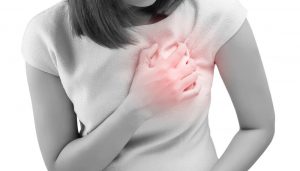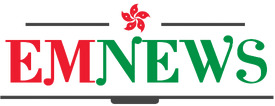 The breast is the specialized glandular tissue overlying the chest (pectoral) muscles. Women’s breasts are made of specialized tissue that produces milk (glandular tissue) as well as fatty tissue. Along with their major function in providing nutrition for infants, female breasts have social and sexual characteristics. They can figure prominently in the perception of a woman’s body and sexual attractiveness. During a woman’s life, her breasts change size, shape, and weight due to hormonal changes during puberty,the menstrual cycle,pregnancy,breastfeeding,and menopause. At puberty, estrogens, in conjunction with growth hormone, cause breast development in female humans and to a much lesser extent in other primates. Breast development in other primate females generally only occurs with pregnancy. Most of the breast changes occurs due to fluctuating levels of reproductive hormones on female breasts. These may include pain and/or swelling, a lump or general ‘lumpiness’, nipple discomfort or fluid from the nipple.
The breast is the specialized glandular tissue overlying the chest (pectoral) muscles. Women’s breasts are made of specialized tissue that produces milk (glandular tissue) as well as fatty tissue. Along with their major function in providing nutrition for infants, female breasts have social and sexual characteristics. They can figure prominently in the perception of a woman’s body and sexual attractiveness. During a woman’s life, her breasts change size, shape, and weight due to hormonal changes during puberty,the menstrual cycle,pregnancy,breastfeeding,and menopause. At puberty, estrogens, in conjunction with growth hormone, cause breast development in female humans and to a much lesser extent in other primates. Breast development in other primate females generally only occurs with pregnancy. Most of the breast changes occurs due to fluctuating levels of reproductive hormones on female breasts. These may include pain and/or swelling, a lump or general ‘lumpiness’, nipple discomfort or fluid from the nipple.
Breast pain, also known as mastalgia, mammalgia, and mastodynia — a common complaint among women presented to our breast clinics. It may include breast tenderness, sharp burning pain or tightness in your breast tissue. The pain may be constant or it may occur only occasionally. Breast pain is more common in younger women who haven’t completed menopause but postmenopausal women sometimes have breast pain.
Types of breast pain in women:
There are 2 broad classification of breast pain of –
1). Cyclic mastalgia : Breast pain clearly related to the mentstrual cycle, occurs in premenopausal women.It is more common type ,which accounts for approximately two third of breast pain in our breast clinics.
2). Noncyclic mastalgia: This type of constant or intermittent breast pain that is not associated with the menstrual cycle. This type of mastalgia accounts for rest of one third of breast pain in breast cinics.
There is another types of pain-
- Extramammary breast pain:

- The term “extramammary” means “outside the breast.”
- Extramammary breast pain feels like it starts in the breast tissue, but its source is actually somewhere else. Pulling a muscle in your chest, for example, can cause pain in your chest wall or rib cage that spreads (radiates) to your breast. For example- costochondritis, pain from heart or lungs etc.
Common causes of breast pain:
A). Non cancerous causes:
- Fibrocystic breast conditions.
- Painful breast cyst
- Traumatic breast pain.
- Inflammation and infections :Mastitis & breast abscess
- Breast lumps (Fibroadenoma)
- Costochondritis
- Scar pain after breast surgery
- Certain medications-
Examples of these types of drugs are:
- oral hormonal contraceptives
- postmenopausal hormonal therapies, such as estrogenand progesterone preparations
- antidepressants, such as selective serotoninreuptake inhibitor (SSRI)
- antipsychotic, such as Haloperidol
- digitalis preparations, for example, digoxin
- Methyldopa
- Spironolactone
B). Cancerous causes:
- Breast cancers (Advanced cases)
Predisposing factors of breast pain:
- Hormonal causes
- High dietary fat intake
- Excess intake of methylexanthines containing drinks such as- tea, coffee,etc
- Smoking
- Large breast size.
- Psychosomatic disorders.
Treatment of Breast pain:
Treatments depend on the causes of breast pain but in general common principle of treatments are-
A). Reassurance
B). Life style modifications:
- Using a supportive bra.

- Dietary fat reduction.
- Some women have found avoiding caffeine & reducing salt intake helpful in relieving symptoms but studies have not shown any significant impact.

- Weight reduction, regular exercise
- Relaxation therapy and psychotherapy.

C). Vitamins and dietary suppliments such as evening prime rose oil and vitamin E.
D). Taking analgesics e.g. Panadol, NSAIDs
E). Sometimes strong hormonal treatment may required e.g. Danazol, Bromocriptin etc.
F). Surgical treatment sometimes needed in refractory non cancerous breast pain e.g. lumpectomy, mastectomy etc.
E). If the pain is for breast cancer, then a multidisciplinary approach needed, where surgeon, histopathologists, onchologists, radiotherapists , nurse etc shall participate.
When to visit a doctor:
Make an appointment with your doctor if breast pain:
- Continues daily for more than a couple of weeks
- Occurs in one specific area of your breast
- Seems to be getting worse over time
- Interferes with daily activities
- Associated with any changes in breast such as- skin changes, lumps, altered coloured (bloody) fluid from nipple etc.

Conclusion:
Most times, breast pain signals a noncancerous (benign) breast condition and rarely indicates breast cancer.A stepwise approach should be adopted when managing breast pain (mastalgia). So early diagnosis and proper managements with reduction of some predisposing factors may reduce breast pain and improve the overall quality of life (QOL) of a female.
Writer:
Dr. Samia Mostary
MBBS, MS Resident (Phase-B)
Dept. of General Surgery, BIRDEM General Hospital,
Shahbag, Dhaka
